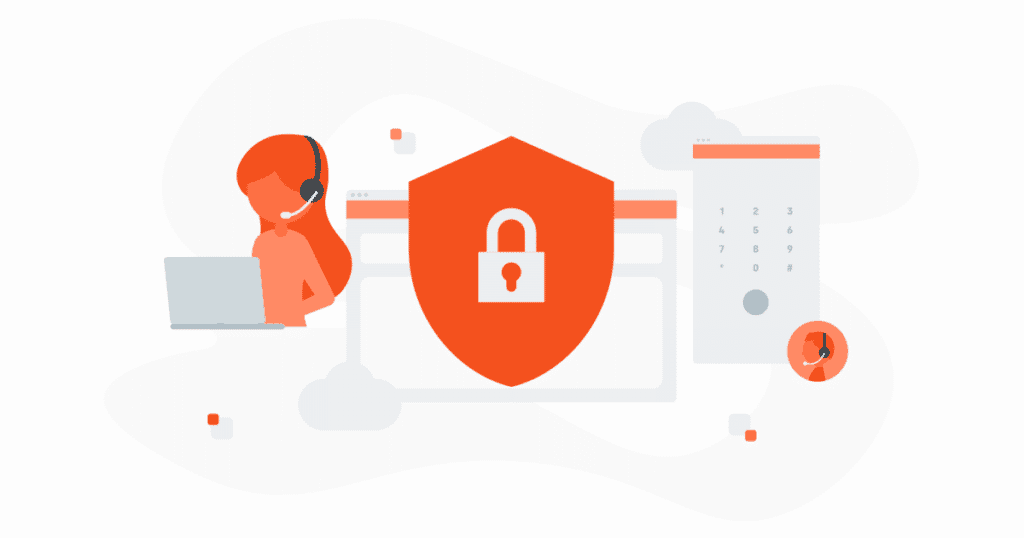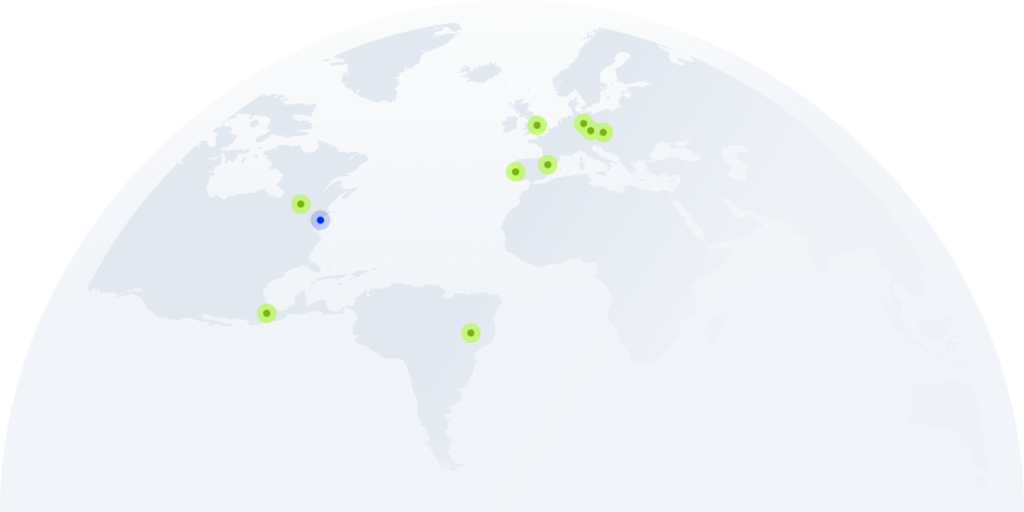9 VoIP Security Vulnerabilities and How to Fix Them

VoIP security is one of those truly pernicious things that you have to keep constant tabs on. Conducting regular security audits might seem like a pain, perhaps even a waste of time, but failing to follow through can put your business in a risky position.
VoIP fraud, DDoS attacks, and Vishing schemes are just a few of the many security threats out there. In this article, we’ll detail nine such threats and offer strategies for coping with them. The best thing you can do for your business’ longevity is educate yourself about potential security vulnerabilities — so read on!
The 9 most common security risks and how to fix them
#1 DDoS Attacks
What is it?
A DDoS, or Distributed denial of service, attack is when cybercriminals intentionally overwhelm a server with data and use up all of its bandwidth. With all of the server’s bandwidth used up, VoIP activities and all internet activity in general grinds to a halt. Disruptions like this can seriously affect a company’s day-to-day operations, as well as its bottom line.
Unfortunately, DDoS attacks are only becoming more common. The equipment needed to carry out a DDoS attack is becoming more advanced, which makes executing these attacks cheaper and faster for cyber criminals. In fact, 70 percent of organizations surveyed by Corero said that they experience approximately 20-50 DDoS attacks per month. And according to the security company Cloudflare, the average cost of a successful DDoS attack is around $100,000 per hour. So what can you do to adequately address these attacks when they happen? Read on to find out.
Secure your phone system
How to fix it
First and foremost, it’s important to identify DDoS attacks early. The sooner you’re able to recognize a problem, the sooner you can work to fix it, right? Set yourself up for success by appointing a DDoS czar at your company, a.k.a. someone whose responsibility it is to act should you come under attack.
Once an attack starts, there are several steps you can take to mitigate the damage:
- Overprovision bandwidth: Though keeping a reserve of bandwidth for emergency situations is unlikely to halt a DDoS attack in its tracks, it can buy you the valuable time you’ll need to contact security experts.
- Contact your ISP: As a general rule, your ISP (Internet Service Provider) is responsible for the security of your network connection and will have staff on hand who can help to mitigate the damage of a DDoS attack. Calling your ISP and making them aware of the attack should be one of your top priorities.
- Reach out to a DDoS specialist: Because DDoS attacks are so complex, you’ll need the help of an experienced expert to get things back under control. Part of the planning you can do before cyber criminals strike is establishing a partnership with a credible DDoS specialist who’ll be able to come to your aid should you experience an attack.
#2 Call Tampering
What is it?
Call tampering occurs when cyber criminals disrupt ongoing calls either by sending a large amount of data along the call path or by delaying the transmission of data between the callers. Both methods result in choppy connections and long periods of silence, which can badly hamper a company’s ability to conduct business over the phone.
How to fix it
Once again, your first step should be to contact your ISP and make them aware of the situation. You should also develop a plan to safeguard your telephony operations from these sorts of calls. One step you can take is to amp up your authentication and encryption efforts. All voice streams coming in and out of your call center should be encrypted, and IP phones should have authentication codes during off-hours. These are good security practices in general, and will help you drastically decrease the incidence of call tampering at your call center.
#3 VoIP Network Firewalls
What is it?
If you’re left scratching your head with this one, we don’t blame you: firewalls are usually a good thing. In the case of VoIP, though, only the most up-to-date firewall systems are compatible with VoIP protocols. Older firewalls won’t recognize VoIP activities and may block some of your call center’s core functions.
How to fix it
It’s simple: make sure to go out and get a modern firewall system. Up-to-date firewalls are guaranteed to boost your security, not weaken it.
#4 Vishing
What is it?
Put simply, vishing is VoIP-based phishing. Much in the same way email phishing scams seek to solicit victims’ sensitive financial information through email links, VoIP vishing scams seek to solicit that information through voicemail messages.
How to fix it
The best method for protecting yourself from vishing scams is to verify all incoming call requests, even if they seem as though they’re coming from within your organization. Furthermore, your agents should be coached to never disclose sensitive information to anyone without the expressed consent of their supervisor.
#5 VoIP Fraud
What is it?
VoIP fraud occurs when cyber criminals hack into your VoIP system and make use of your services without permission. VoIP fraudsters often employ a strategy called toll fraud, wherein they artificially generate a high volume of international calls to premium rate numbers and then collect the revenue. This scam can be especially costly, and often takes place right under your nose.
How to fix it
There are several ways you can insulate yourself from potential VoIP fraud scams. We’ll list some of them below.
- Offer international calling services only to those clients that request it
- Implement time-bound spending limits for your international calling service plans
- Keep track of off-hours usage spikes and investigate when necessary
- Sign shared liability contracts with your clients so you aren’t hung out to dry should VoIP fraud occur
#6 Malware and Viruses
What is it?
Malware and viruses are a perennial threat to any and all network systems, VoIP systems being no exception. They’re especially harmful, too, because they act as a devilish key giving cyber criminals access to your entire system. With that kind of complete access, criminals can steal sensitive information, consume network bandwidth and decrease the quality of your calls with relative ease.
How to fix it
The key to preventing malware and virus attacks lies in thinking ahead: develop a plan for routine security audits, use automated pentesting tools to find any vulnerabilities, implement safety protocols across your business and take steps to ensure your employees comply with company-wide security measures. If you’re diligent in safeguarding your company from security threats, you can successfully avoid the damage that malware and viruses routinely cause.
#7 VOMIT
What is it?
Voice over Misconfigured Internet Telephones, of VOMIT as it’s so colorfully referred to, presents a serious security threat for VoIP phone systems. Hackers use this method to eavesdrop and extract voice packets directly from ongoing calls, thus gaining access to sensitive information such as call origin, usernames and passwords and financial data.
How to fix it
To address this issue, you should strongly consider using a VoIP service provider that automatically encrypts incoming and outgoing calls. CloudTalk, for example, not only encrypts all incoming and outgoing data, it also sets you up with your own PBX (Private Branch Exchange), so you carry out your business operations with peace of mind.
#8 SPIT
What is it?
Another colorfully-named-yet-in-fact-serious security threat is SPIT, which stands for Spam over IP Telephony. Put simply, SPIT is the VoIP equivalent of email spam. SPIT schemes send out pre-recorded voicemail messages and/or robocalls en masse in hopes of tricking unsuspecting marks into picking up the phone and listening to the voicemail messages. If you’re unlucky enough to be the victim of one of these schemes, you can be on the hook for high international calling fees, which are siphoned off by the perpetrators for profit.
How to fix it
While there’s no way to totally prevent SPIT attacks, setting yourself up with a quality VoIP service provider that takes security seriously is a good first step to take. CloudTalk, for example, uses a modern firewall that helps identify spam on arrival so it can’t inflict damage on your company and its clients.
#9 Out-of-date systems
What is it?
Failing to regularly update your VoIP system software can leave you vulnerable to any number of security threats. Many tech administrators fail to update cloud-based VoIP systems because traditional, analog phone systems never needed these sorts of security patches. It’s an understandable oversight, but one that can cause significant damage to your company over time.
How to fix it
The fix here is pretty intuitive: make sure your VoIP software is always up to date! This can be as simple as assigning regular system audits as a task to one of your tech admins, or including a discussion of system updates as an agenda item for your company’s quarterly reviews. However you choose to keep your VoIP systems up to date, make sure you follow through every time. As with so many security efforts in modern business, the key to success in VoIP network security is consistency, consistency, consistency.
The Bottom Line
Security threats may be inevitable, but that doesn’t mean you have to take them lying down. Setting yourself up with the right VoIP service provider can be the difference between being able to shrug off a security threat and having it ruin your business.
CloudTalk was designed with security top of mind. When you use CloudTalk, all of your data is stored in modern data centers with 24/7 monitoring. You can rest easy knowing that your most important information is safe with us.






















